The Wild Wild West

Anthony Skuce goes running with Canada’s new training powerhouse, the B.C. Endurance Project
It’s a Saturday morning in October, eight days before the 2014 Scotiabank Toronto Waterfront Marathon, and I’m driving to Stanley Park to watch elite runners Rob Watson and Kelly Wiebe of the British Columbia Endurance Project do a final longer tune-up workout prior to the race.
It’s raining steadily. I’m on my ancient mountain bike, covered in bulky rain gear. Richard Lee, coach of BCEP, is ready to lead them with his appropriately faster bike so that he can keep up with these two Canadian elites, calling out splits and handing out water bottles mid-run. He has a black eye from a bike crash a week ago while shepherding Wiebe through a long run. He’d been looking at his watch, about to call out a split when a telephone pole knocked him cold. He wasn’t out long, he says, but long enough to freak out his runner. They still finished the workout. He has a helmet on today.
I’d spoken to Richard on the phone a few days before. We talked about how bcep came to be in the fall of 2013, its high performance goals and his coaching philosophy. He admires American running legend Alberto Salazar, seeing him as an instinctual coach, who, like Lee, tried out everything on himself as an athlete. He started running back in high school in Kincardine, Ont. He and his coach knew little about training at first, but he was motivated to learn and try whatever new ideas were out there, to find out for himself what worked and what didn’t.
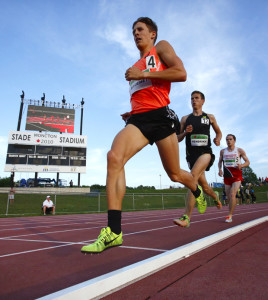 Lee continued running while at Queen’s University, often with his friend – and later best man at his wedding – future running great Steve Boyd. Richard’s wife, Sue Lee, was also a runner, finishing eighth in the 10,000m at the 1988 Olympics, setting a Canadian record of 31:50.51 in the process. Lee was her coach, but he initially saw coaching as a one-off thing, not a career. When Sue retired from running, Richard moved on from coaching. He competed for a while longer, but then geared down in the early 1990’s. In 2009, Vancouver runner Richard Mosley approached him with the idea of forming a training group with 2:16 marathoner Steve Osaduik and Dylan Gant.
Lee continued running while at Queen’s University, often with his friend – and later best man at his wedding – future running great Steve Boyd. Richard’s wife, Sue Lee, was also a runner, finishing eighth in the 10,000m at the 1988 Olympics, setting a Canadian record of 31:50.51 in the process. Lee was her coach, but he initially saw coaching as a one-off thing, not a career. When Sue retired from running, Richard moved on from coaching. He competed for a while longer, but then geared down in the early 1990’s. In 2009, Vancouver runner Richard Mosley approached him with the idea of forming a training group with 2:16 marathoner Steve Osaduik and Dylan Gant.
Meanwhile, top Canadian running talent Dylan Wykes was being coached in Kingston, Ont. by Steve Boyd. Wykes would come out to Vancouver occasionally to race and, because of the Boyd-Lee connection, stayed at Lee’s house. Wykes was tiring of Eastern winters and wanted a change of scenery. So Lee offered to help him with a more one-on-one approach. He says that Wykes’s immense talent was obvious and that he was just putting, “icing on the cake.” He started emailing Wykes workouts in 2010. By September, Wykes was convinced and moved out to Vancouver, which wasn’t an easy thing to do, as his future wife Francine was still working on her PhD in Ottawa.
Their goal was for Wykes to win the Sacramento Marathon in December of 2010, as it had a $10,000 first prize. If Wykes was going to shoot for qualifying for the marathon at the 2012 London Olympics, he couldn’t be on his feet 40 hours a week to make ends meet. They had eight weeks to ice the cake. Wykes nailed it, running a 2:12:38 for the win, and the $10,000. He followed that up with a 2:10:47 at the Rotterdam Marathon the following year, qualifying for London and making him the second fastest Canadian marathoner in history, just 38 seconds off Jerome Drayton’s longstanding record.
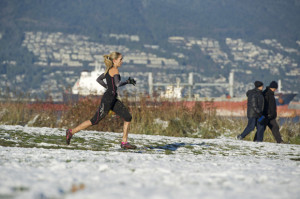 The “Dylan Effect” began to kick in. Fast people want to train with other fast people. Kelly Wiebe moved from Saskatchewan. Rob Watson moved from Guelph, Ont., looking for a reboot. He started by doing a lot of workouts with BCEP while still being coached by his brother Pete, and then officially joined the group in 2013. Luc Bruchet also started training with the group. The talented runner still competed as a university athlete for UBC, but he was frustrated with his progress.
The “Dylan Effect” began to kick in. Fast people want to train with other fast people. Kelly Wiebe moved from Saskatchewan. Rob Watson moved from Guelph, Ont., looking for a reboot. He started by doing a lot of workouts with BCEP while still being coached by his brother Pete, and then officially joined the group in 2013. Luc Bruchet also started training with the group. The talented runner still competed as a university athlete for UBC, but he was frustrated with his progress.
Then Natasha Wodak approached Lee. She had run a blistering 8K in early 2013, but she wanted to focus more on longer distances, pointing towards a fall marathon. Richard devised a program to prepare her for the 2013 Scotiabank Toronto Waterfront Marathon. “The key isn’t having some sort of genius program, or a magic formula,” Lee says, in his typically self-effacing manner. “The physiological principles of training are well known, but it’s tough for an athlete at the highest level to do it herself.” he says of taking on Wodak.
The workouts with BCEP can be killer, and the recovery is crucial. “The mental effort of full-time training is extremely demanding,” Lee says. “You doubt yourself, think too much, miss signs that you need to rest, or that you are ready to go harder. You need to give over the reins to someone who can tell you with confidence what to do and what the result will likely be.” Lee pauses before he states, “I know this stuff works.” Wodak ran a 2:35 debut marathon in Toronto in the fall of 2013.
The athletes begin to arrive. Wodak is there, along with top masters runner Catherine Watkins. Catherine is immediately welcoming and comes across as the group’s really nice mom, which is not an odd role for her, as she is a mother of two. Wodak’s foot is bothering her. She shrugs and says, “Plantar fasciitis,” a brutal, tiresome injury. It can go on and on, never seeming to get any better until finally, if you’re lucky, it just fades away. Wodak has been struggling with it for all of 2014 and it has already ruined much of her year. But she remains upbeat, pointing out that she’s been staying fit by water running, at times with Wykes, whose struggles with injuries over the years has made him a master pool runner.
Rob Watson is there, too, talking about his gig pacing American star marathoner Shalane Flanagan at the Berlin Marathon. Wiebe begins describing a recent Walking Dead-viewing marathon, sporting a big grin, which is his default expression. Mosley, an original member from the formation of the group, is there, too, as are John Corbitt, Justin Kent, Theo Hunt and Adam Byles. They form the second tier of BCEP. They’d be the best guys in almost any other training group in the country.
The women head into the trails for some long intervals. The men, after a warm-up jog around Stanley Park’s Beaver Lake, do some strides and then jog over to the start line for today’s run, just past the rowing club. The clouds are suddenly parting, revealing a blue sky and then the sun, a surprising respite from the forecast of heavy rain, which the group planned on battling. I ask Watson what he’s shooting for in Toronto. “I’m not in the greatest shape,” he says. “I’m hoping to go 2:15.” It’s time to roll. Lee points to the start line and, looking at his stop watch, sends them on their way.
 The pace is brisk through the first kilometre. “Easy, boys,” Lee advises as he rides alongside them. Rounding Lighthouse Point, Wiebe and Watson begin to pull away. They’re doing 12K at their marathon goal pace. I ride behind the second group as they glide through 2K in about 6:20. A large group of tourists stare as the crew flashes by.
The pace is brisk through the first kilometre. “Easy, boys,” Lee advises as he rides alongside them. Rounding Lighthouse Point, Wiebe and Watson begin to pull away. They’re doing 12K at their marathon goal pace. I ride behind the second group as they glide through 2K in about 6:20. A large group of tourists stare as the crew flashes by.
I pedal hard in pursuit of Wiebe and Watson. Approaching Siwash Rock, Wiebe has opened a 15-metre gap. Watson grabs a fluid bottle from Lee and I ask him how he feels. “Not great. Legs are heavy. Have been for a couple weeks,” he says, still sounding upbeat. Over the next couple kilometres he gradually reels Wiebe in. They churn up an incline, consuming huge swaths of territory with each stride. They are both over six-feet tall and gangly. Rob’s stride is deceptive. He moves quickly but looks like he’s ambling along, hands held lightly, thumbs slightly cocked. As they pass by, Wiebe flashes that same grin and throws a thumbs up. They roll easily through the final couple K’s, and when they finish up are almost immediately chatting comfortably, optimistic about next weekend’s marathon.
Race day dawns in Toronto and while conditions aren’t terrible, they aren’t ideal, either. It’s a little too breezy, a little too cold. Watson and Wiebe reach halfway on pace, but by 25K their day is over. Watson’s hamstrings have tightened dramatically and Wiebe’s achilles has flared up badly. They both drop out.
Later, I ask Lee what he thinks went wrong. Watson’s performance, he says, was predictable. He’d just run Berlin a few weeks before, going most of the way at sub-2:20 pace. He wasn’t at peak fitness going into that. Recovering and going faster a couple weeks later, especially when training hadn’t been going well, was always going to be a long shot. As for Wiebe, he notes that being fully prepared to run an elite level marathon takes a “complex combination of talent, hard work and mental capacity;” Something that may come for the young talent, but is still a work in progress. Even after a significant failure for his group, Lee is both carefully analytical and positive about the future of his bcep runners.
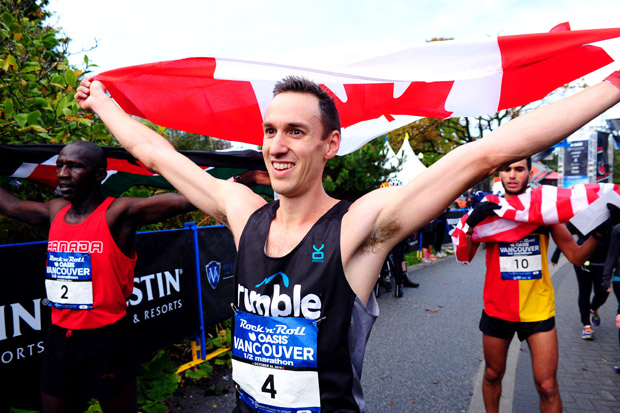
The next weekend, at the Rock ’n’ Roll Vancouver Half-Marathon, BCEP runners fare much better. Geoff Martinson, a former world championship 1,500m semi-finalist now training with BCEP, places second in the men’s race with a 1:05:47. Mosley is fifth in a solid 1:08:51. Natash Wodak also runs well, despite limited training. She grabs fourth in 1:16:45 and Catherine Watkins is the top master and fifth overall in 1:16:48. In the 10K, BCEPs Kevin Friesen wins in 31:01, with Hunt and Corbitt are second and third respectively, less than thirty seconds back.
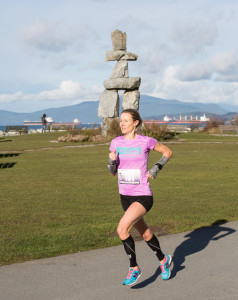 It’s a Tuesday night a couple weeks later and BCEP is working out at the University of British Columbia track. It’s a perfect night for running: 10 C, dry and still. Lee has the details of the workout written on a small white board: “2,400 m/2 min, 2,000/2 min, 1,600/5 min, 1,600/3 min, 1,200/3 min, 1,000/ 3 min, 800/3 min.” They are to start out at 10K pace and then work down as the intervals progress. “This is one of my own, I didn’t get it out of a book,” Lee tells me, with a twinkle in his eye. He knows it’s a bear of a workout. There are seven athletes out for the effort, including Luc Bruchet (who ran 13:33 for 5,000m earlier in the summer, and is just returning from an injury) Wiebe and Martinson. Watkins is here, but not Wodak, as her plantar fasciitis has flared up. It’s not looking good for her to defend as the national cross-country champion in a month. Watkins is training for the Houston Marathon on Jan. 18, 2015, hoping to dip under 2:40. She does the workout solo, ticking off 84 second laps like a metronome. Her flat, efficient stride looks perfectly suited for chewing up 42K. During one of the rests, I comment that it looks like she’s hardly trying, she’s running so smoothly. She smiles and assures me she’s feeling it.
It’s a Tuesday night a couple weeks later and BCEP is working out at the University of British Columbia track. It’s a perfect night for running: 10 C, dry and still. Lee has the details of the workout written on a small white board: “2,400 m/2 min, 2,000/2 min, 1,600/5 min, 1,600/3 min, 1,200/3 min, 1,000/ 3 min, 800/3 min.” They are to start out at 10K pace and then work down as the intervals progress. “This is one of my own, I didn’t get it out of a book,” Lee tells me, with a twinkle in his eye. He knows it’s a bear of a workout. There are seven athletes out for the effort, including Luc Bruchet (who ran 13:33 for 5,000m earlier in the summer, and is just returning from an injury) Wiebe and Martinson. Watkins is here, but not Wodak, as her plantar fasciitis has flared up. It’s not looking good for her to defend as the national cross-country champion in a month. Watkins is training for the Houston Marathon on Jan. 18, 2015, hoping to dip under 2:40. She does the workout solo, ticking off 84 second laps like a metronome. Her flat, efficient stride looks perfectly suited for chewing up 42K. During one of the rests, I comment that it looks like she’s hardly trying, she’s running so smoothly. She smiles and assures me she’s feeling it.
Bruchet and Martinson form the first group, with Hunt, Friesen and Corbitt starting 10 seconds later. Bruchet’s group goes through the first 400m in a pedestrian 74 seconds, followed by a 70, then another 70. Tonight is the first time I’ve seen Bruchet run. Sometimes runners look like they would only be good at running, all skeletal and spindly. But Bruchet, sporting a trim, Errol Flynn mustache, looks athletic, like he’d be good at any number of sports. I ask him later if he hopes to make the Olympics. “Yeah, that’s always been his dream since I was a kid, in whatever sport I happened to be doing at the time,” he laughs. Now it’s running. I remark to Lee on Bruchet’s powerful-looking form. Lee nods. “Luc is on a serious improvement curve,” Lee says, carefully monitoring their progress. “It’ll be interesting to see how far it takes him,” he observes, making no predictions. Commit to the process. See what happens.
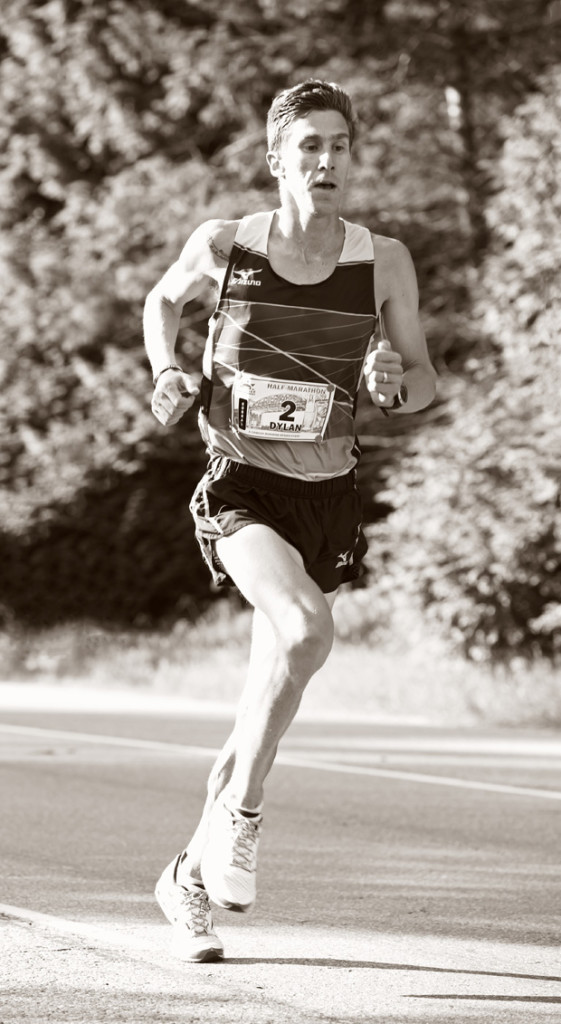 Saturday morning arrives. It’s another blue sky day, perfect conditions for the four-mile time trial at the UBC track that’s on tap. Luc Bruchet and Kelly Wiebe are here for a final hard tune-up before heading to Japan for the prestigious Chiba Ekiden relay. Mosley is here and looks exhausted. His wife had just given birth six days ago. Dylan Wykes is here too. This is his first group workout since he was injured preparing for the Scotiabank Toronto Waterfront Marathon. I’d watched him do a workout on an Alter-G treadmill at UBC the week before. We chatted as he strode along inside what looked like a pressurized baggie meant to reduce the punishing effect of gravity on the human body. His injury was fully healed, and he had done some runs on the nearby trails, but he was working his way back carefully. He said he’d decided to incorporate pool runs and antigravity runs into his regular schedule as a way of maximizing volume and minimizing wear and tear from here on in. We talked about how he couldn’t seem to shake injury problems since the London Olympics, which were now over two years ago. He said that there were points after London when he thought he might be done. But instead he is now fully committed and excited to complete some unfinished business. As for the injuries, he noted that while he tried to find out what went wrong and fix the problem, sometimes it’s just a matter of the huge volume and pushing too hard. Injuries, although frustrating, are a part of the sport. He talked about his plans for 2015. The marathon qualifying window for Rio opens early in the year, but he wants to be patient, run some track, get fast. “In university, I was more of a 1,500 and 5,000m guy that kind of stumbled upon the marathon,” he says sheepishly. Canada’s second fastest marathoner of all-time didn’t necessarily see himself as a “real” marathoner.
Saturday morning arrives. It’s another blue sky day, perfect conditions for the four-mile time trial at the UBC track that’s on tap. Luc Bruchet and Kelly Wiebe are here for a final hard tune-up before heading to Japan for the prestigious Chiba Ekiden relay. Mosley is here and looks exhausted. His wife had just given birth six days ago. Dylan Wykes is here too. This is his first group workout since he was injured preparing for the Scotiabank Toronto Waterfront Marathon. I’d watched him do a workout on an Alter-G treadmill at UBC the week before. We chatted as he strode along inside what looked like a pressurized baggie meant to reduce the punishing effect of gravity on the human body. His injury was fully healed, and he had done some runs on the nearby trails, but he was working his way back carefully. He said he’d decided to incorporate pool runs and antigravity runs into his regular schedule as a way of maximizing volume and minimizing wear and tear from here on in. We talked about how he couldn’t seem to shake injury problems since the London Olympics, which were now over two years ago. He said that there were points after London when he thought he might be done. But instead he is now fully committed and excited to complete some unfinished business. As for the injuries, he noted that while he tried to find out what went wrong and fix the problem, sometimes it’s just a matter of the huge volume and pushing too hard. Injuries, although frustrating, are a part of the sport. He talked about his plans for 2015. The marathon qualifying window for Rio opens early in the year, but he wants to be patient, run some track, get fast. “In university, I was more of a 1,500 and 5,000m guy that kind of stumbled upon the marathon,” he says sheepishly. Canada’s second fastest marathoner of all-time didn’t necessarily see himself as a “real” marathoner.


